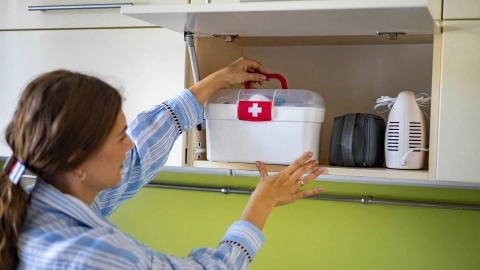Health care Medicinal products: dosage forms and routes of administration
Medicinal products or medication can be taken or administered in several ways, for example as tablets, suspensions, suppositories, ointments, shots or sprays. The dosage form and route of administration depend on various factors including where, how and how quickly the medicinal product should take effect.
At a glance
- Medicinal products can take effect locally or systemically throughout the entire body.
- There are a variety of dosage forms, for example solid in the form of tablets, semi-solid in the form of ointments or liquid in the form of suspensions.
- Medicinal products can be used in various ways, for example swallowed, injected or applied to the skin.
- Some active substances are partially broken down in the liver before they can take effect. This can be prevented or reduced by certain routes of administration.

Why are there different dosage forms and routes of administration?
Medicinal products and drugs come in various formats. They can be swallowed as tablets, applied as an ointment or administered as an injection or infusion. The way in which the medicinal product is delivered to the body depends on various factors including where, when and for how long it should take effect.
Some medicinal products are locally acting and are directly applied to the place where they should take effect. These include lozenges for sore throats and creams to treat itching. With other dosage forms, such as tablets or capsules to swallow or infusions via veins, the medication enters the bloodstream, is circulated and thus has a systemic effect on the body as a whole.
The body can absorb the medicinal products’ active substances via the skin, the mucous membranes or the intestinal wall. If medicinal products need to take effect as quickly as possible – for example in emergencies – they are directly injected into the blood via a vein or directed into the bloodstream using an infusion. If, on the other hand, they have to be administered in small doses or over a longer period, suitable choices include dosage forms with a delayed active substance release, such as time-delay tablets, active substance patches, implants, or depot injections.
Some forms of medication, such as insulin and many vaccines, have to be administered by means of an injection or infusion to prevent the active substances from being broken down during the digestive process and losing their effect. The breakdown of active substances in the liver – the first pass effect – also has to be taken into account with regard to the dosage form.
As a general rule, it is important to always precisely follow the instructions on how to take or administer medicinal products. Information about this can be found in the package insert.
What dosage forms are there?
The dosage form of a medicinal product depends on where, when and for how long it should take effect in the body. For children, some medicinal products are offered as suspensions or suppositories to make them easier to use.
Solid
Solid medicinal product dosage forms include tablets and capsules, for example. Uncoated tablets are made of compressed powder or granules. Film-coated tablets are coated with a layer that protects the active substances contained while also making them easier to swallow. Capsules have a shell that dissolves in the stomach or intestine and then releases the active substance.
There are also effervescent tablets for dissolving in water, chewable tablets, lozenges and melting tablets. Some tablets and capsules are designed to release their active substances slowly over a longer period (time-delay function).
Semi-solid
Semi-solid dosage forms include ointments, creams and gels. An ointment is a viscous paste containing fat, oil or wax. Creams are a mixture of fat and water and spread more easily than ointments. Gels do not contain any fat but instead a lot of water and are particularly easy to apply. Ointments, creams and gels are applied to the skin (cutaneously) or the mucous membranes.
Liquid
Liquid dosage forms include suspensions, syrups, tinctures, eye and nose drops and injection solutions. With a suspension, the active substances are generally dissolved in water or the liquid itself is the active substance. A syrup is a viscous sugar solution in which the active substance is dissolved. A measuring spoon or cup is usually supplied in the packaging to enable suspensions and syrups to be administered in the correct dose. Tinctures are liquid medicinal products for application. Drops can be taken directly or mixed with water or dropped into the eyes, nose or ears. Injection and infusion solutions are liquid medicinal products administered by syringe or drip.
Other dosage forms
Medicinal products also come in many other dosage forms:
- Sprays: for inhalation, for example asthmatic spray
- Patches: for slow active substance release via the skin, for example nicotine or contraceptive patches
- Soluble powder/granules: for dissolving in water, for example over-the-counter cold remedies
- Suppositories: for insertion into the anus (rectal insertion), for example fever suppositories, or the vagina (vaginal insertion)
- Medicated body powder: for applying onto the skin, for example to combat fungal skin infections
What are the most common routes of administration for medicinal products?
Active substances in medication can get into the body in various ways. The route of administration usually depends on the desired effect. It is also important whether the effect should occur immediately or gradually.
Oral route: in or via the mouth
Many medicinal products are taken via the mouth (orally). These can be in tablet, capsule, drop or suspension form. Some take effect directly within mouth and throat, for example sore throat tablets. With others, the active substances are absorbed by the oral mucosa and later the digestive tract before entering the bloodstream.
Buccal and sublingual routes: via the oral mucosa
Some tablets or painkillers are placed in the cheek (buccal) or under the tongue (sublingual) and left there to dissolve. This allows the active substances to quickly get into the blood via the oral mucosa. This effect is used in the case of sedatives, painkillers and even bite capsules for attacks of chest pain (angina pectoris).
Nasal route: in or via the nose
Administration via the nose (nasal) mainly occurs in the case of cold remedies, for example decongestant nasal sprays or drops. However, the well-circulated nasal mucosa is also suitable for systemic treatments, for example in the case of pain attacks that can be treated with special nasal sprays. Individual vaccines are now also available in a form that can be administered nasally. These include flu vaccines for children and adolescents.
Aural route: in the ear
Locally acting drops are the main form of medication used in the ear (aurally). These can alleviate pain, inflammation and itching or blocked ear canals.
Cutaneous route: on the skin
Medicinal products such as ointments and gels are applied to the skin (cutaneously). Some affect the treated area directly (locally), for example in the case of insect bites or itching.
Transdermal route: via the skin
Some medicinal products applied to the skin, such as nicotine or painkiller patches, do not take effect on the skin itself. The active substance enters the bloodstream via the skin (transdermally). Patches release their active substances gradually.
Subcutaneous route: under the skin
If medicinal products are injected under the skin (subcutaneously) into the subcutaneous fatty tissue, they enter the bloodstream slowly. This method can be used to administer medicinal products that would otherwise be broken down in the stomach and intestines, for example insulin, which is required by many people with diabetes.
Rectal route: via the anus
Certain medicinal products such as suppositories or enemas are introduced via the anus (rectally). Enemas act locally in the intestine to combat constipation. Painkiller or fever suppositories, on the other hand, have a systemic effect. They dissolve at body temperature and thus release their active substances. These are absorbed into the bloodstream via the rectum’s mucous membrane and distributed throughout the body.
Intravenous route: via the veins
If medicinal products need to act quickly or achieve the highest efficacy level, they can be administered into the veins (intravenously). This enables them to enter the bloodstream directly. This can be the case with painkillers or antibiotics. The products are administered by medically trained personnel using a syringe as an injection or a drip as an infusion.
Inhaled route: in or via the lungs
Medication can be breathed in (inhaled) as a spray or fine powder. This enables the active substances in asthmatic sprays, for example, to directly enter the lungs, from where they are absorbed via the bronchi’s mucous membranes.
Intramuscular route: into the muscles
Medicinal products are injected into the muscles (intramuscularly) if they should take delayed effect over a longer period. This is known as a depot effect and is used, for example, with hormonal contraceptives administered as injections every three months. Many vaccines are also injected into the muscles – usually in the upper arm or thigh.
Vaginal route: in the vagina
Women can insert medicines such as ointments or suppositories into the vagina (vaginally). These take effect locally, for example in the case of vaginal infections.
What is the first pass effect?
The first pass effect describes a loss of active substance in the liver. It must be considered when determining the dose of medication.
Many medicinal products enter the blood and then the liver via the intestines. During this first pass through the liver, many of the substances dissolved in the blood are altered or broken down. As a result, only a small residual amount of the original dose of some medicinal products gets into the bloodstream and is able to take effect. This is known as the “bioavailable” amount.
Medicinal products with a high first pass effect therefore have to be administered in a higher dose. Alternatively, they are administered via a route that bypasses the first pass effect:
- rectal route (via the anus)
- sublingual route (via the oral mucosa)
- transdermal route (via the skin)
- subcutaneous route (under the skin)
- intramuscular route (into the muscles)
- nasal route (via the nose)
- intravenous route (via the veins)
- Institut für Qualität und Wirtschaftlichkeit im Gesundheitswesen (IQWiG). Gesundheitsinformation.de. Medikamenten-Anwendung. Aufgerufen am 08.05.2025.
- Institut für Qualität und Wirtschaftlichkeit im Gesundheitswesen (IQWiG). Gesundheitsinformation.de. Medikamente zum Auftragen auf die Haut. Aufgerufen am 08.05.2025.
- Institut für Qualität und Wirtschaftlichkeit im Gesundheitswesen (IQWiG). Gesundheitsinformation.de. Medikamente zum Einnehmen. Aufgerufen am 08.05.2025.
- Institut für Qualität und Wirtschaftlichkeit im Gesundheitswesen (IQWiG). Gesundheitsinformation.de. Spritzen, Zäpfchen und weitere Darreichungsformen. Aufgerufen am 08.05.2025.
- Springer Medizin. Lexikon der Medizinischen Laboratoriumsdiagnostik. First-Pass-Effekt. Aufgerufen am 08.05.2025.
In cooperation with the Federal Institute for Drugs and Medical Devices (BfArM).
As at:





